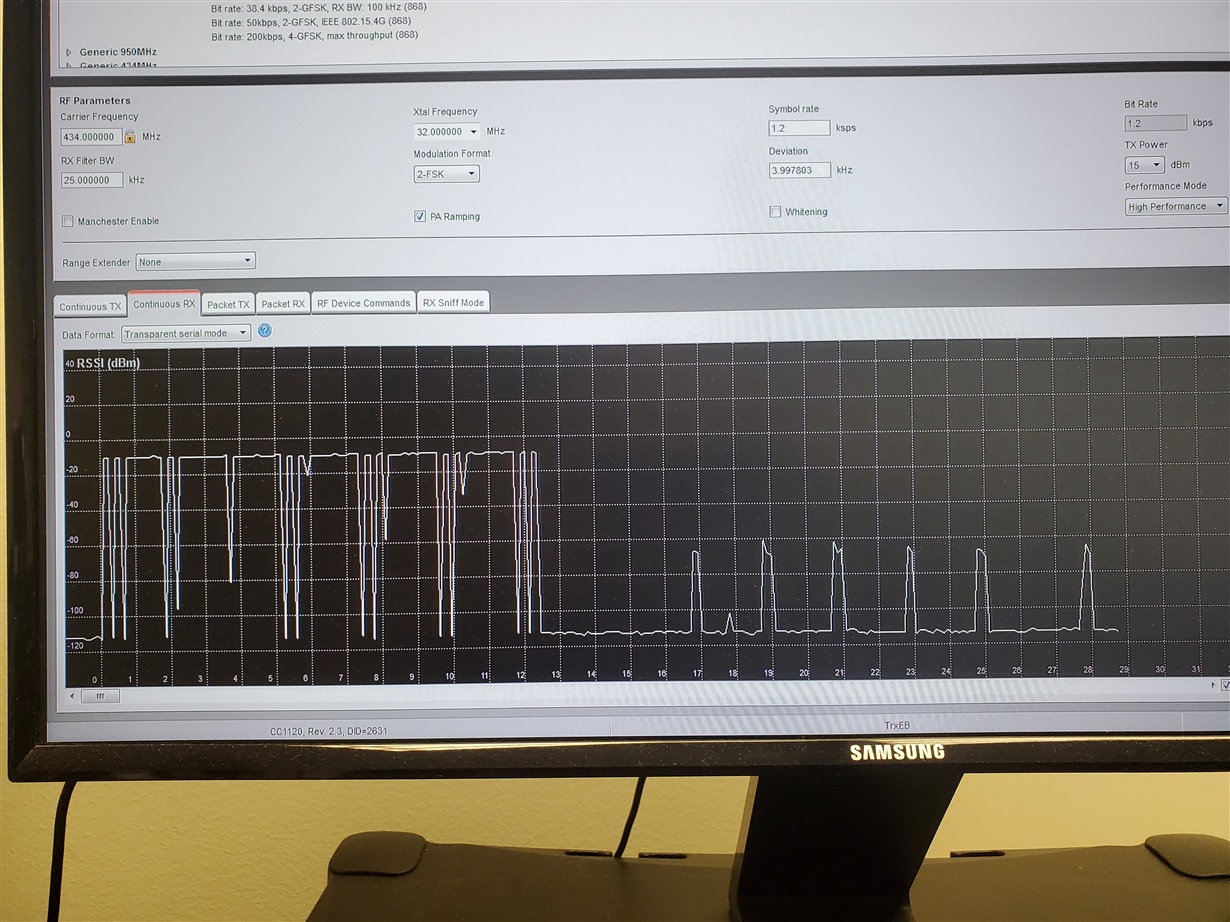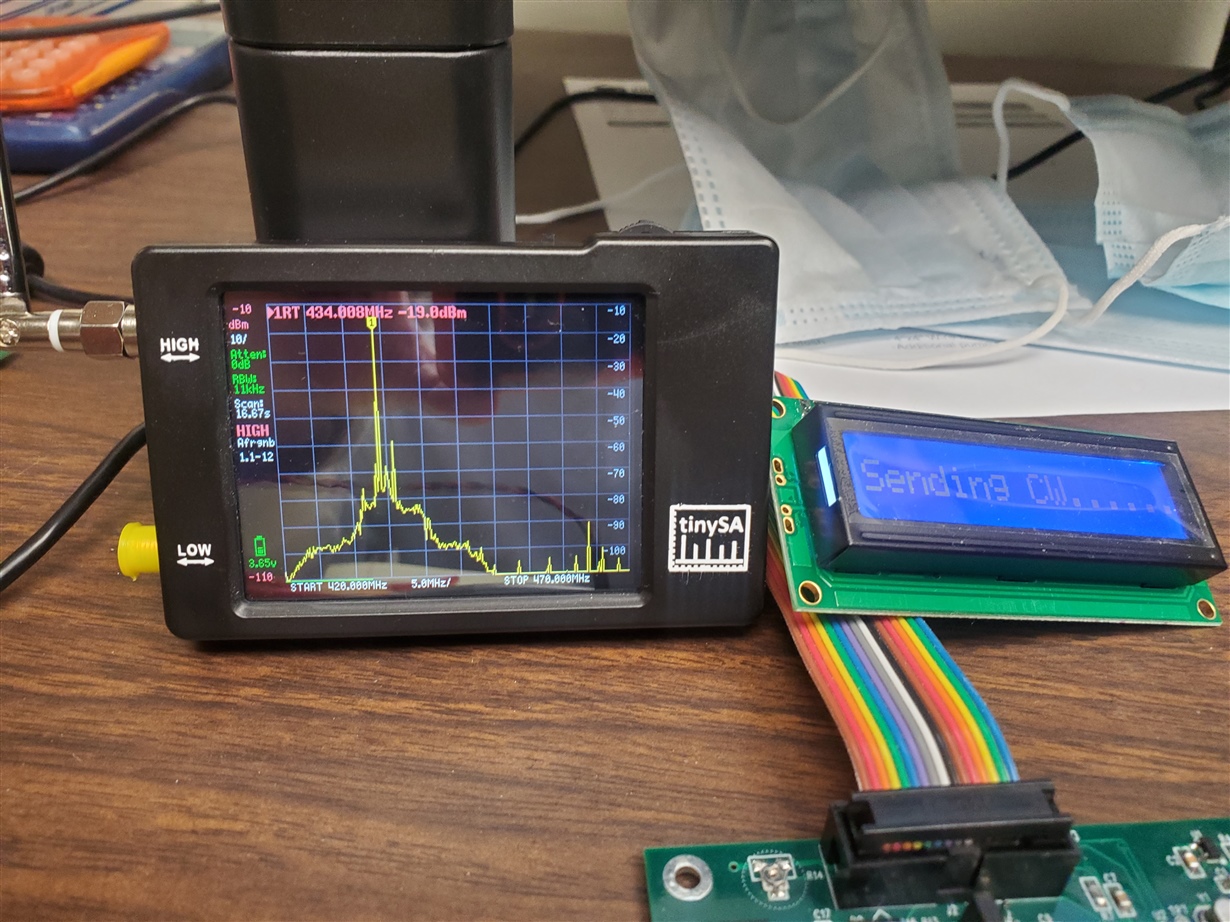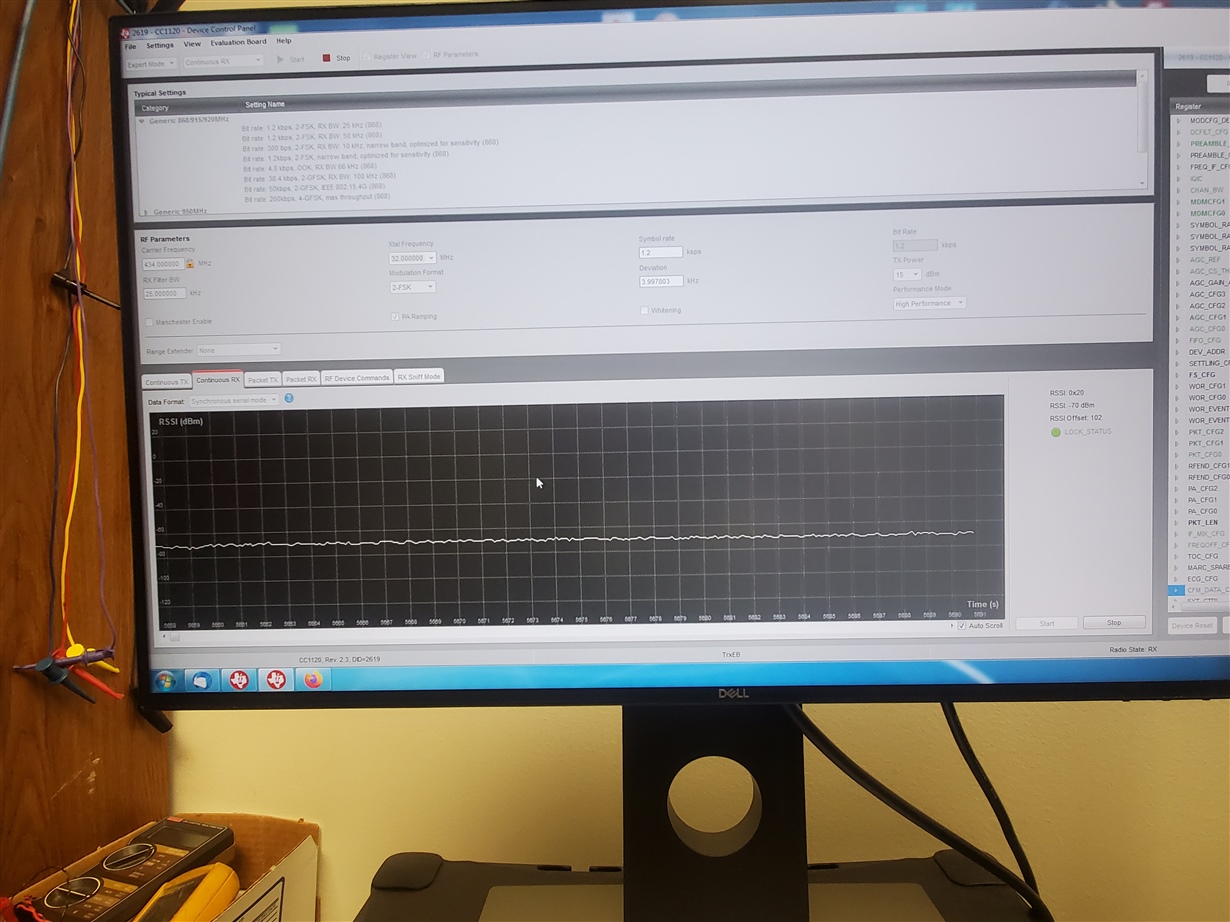So, I'm still searching for answers on a few issues with my CC1120. I have a working custom RX and TX setup (2 similar but different boards) that works in Packet RX mode. I send a packet from the RX, it is received every time by the RX at about -30db. My RX registers are slightly different from the SmartRF registers for Packet RX, but not many. Mostly with a different SYNC and fixed packet length of 10. My TX registers slightly changed from the SmartRF Packet TX. It seems to work well in this mode.
My issue started when I put the RX in RF Sniff mode. It was working, then I discovered that my RX was on 434MHZ and my TX was on 800MHZ (my mistake - I forgot the change the register). I thought that was strange that it worked like that. I didn't do that intentionally. When I changed it so that both were on 434MHZ, RF Sniff didn't work. I've been trying to figure that out, but haven't yet.
So, I stepped back a little and fired up my TRXEB board. It has a 434MHZ daughter board. I set the registers exactly like my RX custom board (except the IOCFG - they work slightly different on my boards). But, the TRXEB is not receiving any packets from my TX board. My RX continues to receive every packet.
I have attached my saved TX and RX configs in case anyone spots anything. Don't know what it could be since those settings work on my boards.
When you "Open CFG" in SmartRF, does it automatically load those settings into the TRXEB? I don't see any indication of that to confirm that. Also, I noticed that the Variable Packet Length field doesn't change when Fixed is loaded.
So, eventually, I hope to figure out the RF Sniff problem, but I want to figure out why the eval board doesn't communicate with my TX with my settings.
<?xml version="1.0" encoding="ISO-8859-1"?>
<!DOCTYPE configuration SYSTEM "C:/Program Files (x86)/Texas Instruments/SmartRF Tools/SmartRF Studio 7/config/xml/configdata.dtd"[]>
<dcpanelconfiguration>
<Devicename>CC1120</Devicename>
<Description>Saved configuration data</Description>
<registersettings>
<Register>
<Name>AGC_CFG1</Name>
<Value>0xa9</Value>
</Register>
<Register>
<Name>AGC_CS_THR</Name>
<Value>0x19</Value>
</Register>
<Register>
<Name>AGC_REF</Name>
<Value>0x20</Value>
</Register>
<Register>
<Name>CHAN_BW</Name>
<Value>0x08</Value>
</Register>
<Register>
<Name>DCFILT_CFG</Name>
<Value>0x1c</Value>
</Register>
<Register>
<Name>FIFO_CFG</Name>
<Value>0x00</Value>
</Register>
<Register>
<Name>FREQ1</Name>
<Value>0x80</Value>
</Register>
<Register>
<Name>FREQ2</Name>
<Value>0x6c</Value>
</Register>
<Register>
<Name>FREQOFF_CFG</Name>
<Value>0x22</Value>
</Register>
<Register>
<Name>FS_CAL0</Name>
<Value>0x0e</Value>
</Register>
<Register>
<Name>FS_CAL1</Name>
<Value>0x40</Value>
</Register>
<Register>
<Name>FS_CFG</Name>
<Value>0x14</Value>
</Register>
<Register>
<Name>FS_DIG0</Name>
<Value>0x5f</Value>
</Register>
<Register>
<Name>FS_DIG1</Name>
<Value>0x00</Value>
</Register>
<Register>
<Name>FS_DIVTWO</Name>
<Value>0x03</Value>
</Register>
<Register>
<Name>FS_DSM0</Name>
<Value>0x33</Value>
</Register>
<Register>
<Name>FS_DVC0</Name>
<Value>0x17</Value>
</Register>
<Register>
<Name>FS_PFD</Name>
<Value>0x50</Value>
</Register>
<Register>
<Name>FS_PRE</Name>
<Value>0x6e</Value>
</Register>
<Register>
<Name>FS_REG_DIV_CML</Name>
<Value>0x14</Value>
</Register>
<Register>
<Name>FS_SPARE</Name>
<Value>0xac</Value>
</Register>
<Register>
<Name>FS_VCO0</Name>
<Value>0xb4</Value>
</Register>
<Register>
<Name>IF_MIX_CFG</Name>
<Value>0x00</Value>
</Register>
<Register>
<Name>IOCFG0</Name>
<Value>0x40</Value>
</Register>
<Register>
<Name>IOCFG1</Name>
<Value>0xb0</Value>
</Register>
<Register>
<Name>IOCFG2</Name>
<Value>0x06</Value>
</Register>
<Register>
<Name>IOCFG3</Name>
<Value>0xb0</Value>
</Register>
<Register>
<Name>IQIC</Name>
<Value>0xc6</Value>
</Register>
<Register>
<Name>MDMCFG0</Name>
<Value>0x05</Value>
</Register>
<Register>
<Name>MODEM_STATUS1</Name>
<Value>0x10</Value>
</Register>
<Register>
<Name>PARTNUMBER</Name>
<Value>0x48</Value>
</Register>
<Register>
<Name>PARTVERSION</Name>
<Value>0x23</Value>
</Register>
<Register>
<Name>PKT_CFG1</Name>
<Value>0x15</Value>
</Register>
<Register>
<Name>PKT_LEN</Name>
<Value>0x0a</Value>
</Register>
<Register>
<Name>PREAMBLE_CFG1</Name>
<Value>0x18</Value>
</Register>
<Register>
<Name>SYNC0</Name>
<Value>0x76</Value>
</Register>
<Register>
<Name>SYNC1</Name>
<Value>0x65</Value>
</Register>
<Register>
<Name>SYNC2</Name>
<Value>0x71</Value>
</Register>
<Register>
<Name>SYNC3</Name>
<Value>0x65</Value>
</Register>
<Register>
<Name>SYNC_CFG1</Name>
<Value>0x0b</Value>
</Register>
<Register>
<Name>XOSC1</Name>
<Value>0x03</Value>
</Register>
<Register>
<Name>XOSC5</Name>
<Value>0x0e</Value>
</Register>
</registersettings>
<dcpanel>
<Property role="44" name="m_chkRegView">2</Property>
<Property role="44" name="m_chkCmdView">0</Property>
<Property role="44" name="m_chkRfParameters">2</Property>
<Property role="46" name="m_cmbUserMode">1</Property>
<Property role="33" name="m_easyModeSettings">-1</Property>
<Property role="33" name="m_typicalSettings">-1</Property>
<Property role="37" name="m_testFuncPanel">3</Property>
</dcpanel>
<rfparameters>
<Property role="46" name="m_cmbFrontends">0</Property>
<Property role="44" name="m_chkHGMorBYP">2</Property>
<Property role="46" name="m_cmbEmRevs">-1</Property>
<Property role="46" name="Xtal Frequency">32.000000</Property>
</rfparameters>
<conttx>
<Property role="45" name="m_rbtModulated">1</Property>
<Property role="45" name="m_rbtUnmodulated">0</Property>
<Property role="46" name="m_cmbDataFormat">-1</Property>
<Property role="44" name="m_chkFreqSweep">0</Property>
<Property role="44" name="m_chkChanSweep">0</Property>
</conttx>
<contrx>
<Property role="46" name="m_cmbDataFormat">-1</Property>
<Property role="44" name="m_chkAutoScroll">2</Property>
</contrx>
<packettx>
<Property role="42" name="m_edtPayloadSize">10</Property>
<Property role="42" name="m_edtPacketCount">100</Property>
<Property role="42" name="m_edtPacketCountEsy">100</Property>
<Property role="42" name="m_edtRandomPacketData">49 2c 80 7e c5 99 d5 e9 80 </Property>
<Property role="42" name="m_edtPacketData"></Property>
<Property role="42" name="m_edtAccessAddress"></Property>
<Property role="42" name="m_edtDeviceAddress"></Property>
<Property role="44" name="m_chkAddSeqNbr">2</Property>
<Property role="44" name="m_chkInfinite">0</Property>
<Property role="44" name="m_chkInfiniteEsy">0</Property>
<Property role="45" name="m_rbtRandom">1</Property>
<Property role="45" name="m_rbtText">0</Property>
<Property role="45" name="m_rbtHex">0</Property>
<Property role="44" name="m_chkAdvanced">0</Property>
</packettx>
<packetrx>
<Property role="42" name="m_edtPacketCount">100</Property>
<Property role="42" name="m_edtPacketCountEsy">100</Property>
<Property role="42" name="m_edtAccessAddress"></Property>
<Property role="44" name="m_chkInfinite">0</Property>
<Property role="44" name="m_chkInfiniteEsy">0</Property>
<Property role="46" name="m_cmbViewFormat">0</Property>
<Property role="44" name="m_chkSeqNbrIncluded">2</Property>
<Property role="42" name="m_edtDumpFile"></Property>
<Property role="44" name="m_chkAdvanced">0</Property>
<Property role="44" name="m_chk802154gMode">0</Property>
</packetrx>
<commandpanel>
<Property role="44" name="m_chkInsertLength">0</Property>
<Property role="42" name="m_edtTxFifo"></Property>
<Property role="42" name="m_edtRxFifo"></Property>
<Property role="46" name="m_cmbInstrInput">-1</Property>
</commandpanel>
<packetRxSniffMode>
<Property role="42" name="m_edtPreambleLength">4</Property>
<Property role="42" name="m_edtCarrierSenseThreshold">-77</Property>
<Property role="45" name="m_rbtRssi">1</Property>
<Property role="45" name="m_rbtPreamble">0</Property>
</packetRxSniffMode>
</dcpanelconfiguration>
<?xml version="1.0" encoding="ISO-8859-1"?>
<!DOCTYPE configuration SYSTEM "C:/Program Files (x86)/Texas Instruments/SmartRF Tools/SmartRF Studio 7/config/xml/configdata.dtd"[]>
<dcpanelconfiguration>
<Devicename>CC1120</Devicename>
<Description>Saved configuration data</Description>
<registersettings>
<Register>
<Name>AGC_CFG0</Name>
<Value>0xcf</Value>
</Register>
<Register>
<Name>AGC_CFG1</Name>
<Value>0xa9</Value>
</Register>
<Register>
<Name>AGC_CS_THR</Name>
<Value>0x19</Value>
</Register>
<Register>
<Name>AGC_REF</Name>
<Value>0x20</Value>
</Register>
<Register>
<Name>CHAN_BW</Name>
<Value>0x08</Value>
</Register>
<Register>
<Name>DCFILT_CFG</Name>
<Value>0x1c</Value>
</Register>
<Register>
<Name>FIFO_CFG</Name>
<Value>0x00</Value>
</Register>
<Register>
<Name>FREQ1</Name>
<Value>0x80</Value>
</Register>
<Register>
<Name>FREQ2</Name>
<Value>0x6c</Value>
</Register>
<Register>
<Name>FREQOFF_CFG</Name>
<Value>0x22</Value>
</Register>
<Register>
<Name>FS_CAL0</Name>
<Value>0x0e</Value>
</Register>
<Register>
<Name>FS_CAL1</Name>
<Value>0x40</Value>
</Register>
<Register>
<Name>FS_CFG</Name>
<Value>0x14</Value>
</Register>
<Register>
<Name>FS_DIG0</Name>
<Value>0x5f</Value>
</Register>
<Register>
<Name>FS_DIG1</Name>
<Value>0x00</Value>
</Register>
<Register>
<Name>FS_DIVTWO</Name>
<Value>0x03</Value>
</Register>
<Register>
<Name>FS_DSM0</Name>
<Value>0x33</Value>
</Register>
<Register>
<Name>FS_DVC0</Name>
<Value>0x17</Value>
</Register>
<Register>
<Name>FS_PFD</Name>
<Value>0x50</Value>
</Register>
<Register>
<Name>FS_PRE</Name>
<Value>0x6e</Value>
</Register>
<Register>
<Name>FS_REG_DIV_CML</Name>
<Value>0x14</Value>
</Register>
<Register>
<Name>FS_SPARE</Name>
<Value>0xac</Value>
</Register>
<Register>
<Name>FS_VCO0</Name>
<Value>0xb4</Value>
</Register>
<Register>
<Name>IF_MIX_CFG</Name>
<Value>0x00</Value>
</Register>
<Register>
<Name>IOCFG0</Name>
<Value>0x40</Value>
</Register>
<Register>
<Name>IOCFG1</Name>
<Value>0xb0</Value>
</Register>
<Register>
<Name>IOCFG2</Name>
<Value>0x06</Value>
</Register>
<Register>
<Name>IOCFG3</Name>
<Value>0xb0</Value>
</Register>
<Register>
<Name>IQIC</Name>
<Value>0xc6</Value>
</Register>
<Register>
<Name>MDMCFG0</Name>
<Value>0x05</Value>
</Register>
<Register>
<Name>PKT_CFG0</Name>
<Value>0x15</Value>
</Register>
<Register>
<Name>PKT_LEN</Name>
<Value>0x0a</Value>
</Register>
<Register>
<Name>PREAMBLE_CFG1</Name>
<Value>0x18</Value>
</Register>
<Register>
<Name>SYNC0</Name>
<Value>0x76</Value>
</Register>
<Register>
<Name>SYNC1</Name>
<Value>0x65</Value>
</Register>
<Register>
<Name>SYNC2</Name>
<Value>0x71</Value>
</Register>
<Register>
<Name>SYNC3</Name>
<Value>0x65</Value>
</Register>
<Register>
<Name>SYNC_CFG1</Name>
<Value>0x0b</Value>
</Register>
<Register>
<Name>XOSC1</Name>
<Value>0x03</Value>
</Register>
<Register>
<Name>XOSC5</Name>
<Value>0x0e</Value>
</Register>
</registersettings>
<dcpanel>
<Property role="44" name="m_chkRegView">2</Property>
<Property role="44" name="m_chkCmdView">0</Property>
<Property role="44" name="m_chkRfParameters">2</Property>
<Property role="46" name="m_cmbUserMode">1</Property>
<Property role="33" name="m_easyModeSettings">-1</Property>
<Property role="33" name="m_typicalSettings">-1</Property>
<Property role="37" name="m_testFuncPanel">2</Property>
</dcpanel>
<rfparameters>
<Property role="46" name="m_cmbFrontends">0</Property>
<Property role="44" name="m_chkHGMorBYP">2</Property>
<Property role="46" name="m_cmbEmRevs">-1</Property>
<Property role="46" name="Xtal Frequency">32.000000</Property>
</rfparameters>
<conttx>
<Property role="45" name="m_rbtModulated">1</Property>
<Property role="45" name="m_rbtUnmodulated">0</Property>
<Property role="46" name="m_cmbDataFormat">-1</Property>
<Property role="44" name="m_chkFreqSweep">0</Property>
<Property role="44" name="m_chkChanSweep">0</Property>
</conttx>
<contrx>
<Property role="46" name="m_cmbDataFormat">-1</Property>
<Property role="44" name="m_chkAutoScroll">2</Property>
</contrx>
<packettx>
<Property role="42" name="m_edtPayloadSize">10</Property>
<Property role="42" name="m_edtPacketCount">100</Property>
<Property role="42" name="m_edtPacketCountEsy">100</Property>
<Property role="42" name="m_edtRandomPacketData">44 40 66 d0 6b c4 30 b7 32 </Property>
<Property role="42" name="m_edtPacketData"></Property>
<Property role="42" name="m_edtAccessAddress"></Property>
<Property role="42" name="m_edtDeviceAddress"></Property>
<Property role="44" name="m_chkAddSeqNbr">2</Property>
<Property role="44" name="m_chkInfinite">0</Property>
<Property role="44" name="m_chkInfiniteEsy">0</Property>
<Property role="45" name="m_rbtRandom">1</Property>
<Property role="45" name="m_rbtText">0</Property>
<Property role="45" name="m_rbtHex">0</Property>
<Property role="44" name="m_chkAdvanced">0</Property>
</packettx>
<packetrx>
<Property role="42" name="m_edtPacketCount">100</Property>
<Property role="42" name="m_edtPacketCountEsy">100</Property>
<Property role="42" name="m_edtAccessAddress"></Property>
<Property role="44" name="m_chkInfinite">0</Property>
<Property role="44" name="m_chkInfiniteEsy">0</Property>
<Property role="46" name="m_cmbViewFormat">0</Property>
<Property role="44" name="m_chkSeqNbrIncluded">2</Property>
<Property role="42" name="m_edtDumpFile"></Property>
<Property role="44" name="m_chkAdvanced">0</Property>
<Property role="44" name="m_chk802154gMode">0</Property>
</packetrx>
<commandpanel>
<Property role="44" name="m_chkInsertLength">0</Property>
<Property role="42" name="m_edtTxFifo"></Property>
<Property role="42" name="m_edtRxFifo"></Property>
<Property role="46" name="m_cmbInstrInput">-1</Property>
</commandpanel>
<packetRxSniffMode>
<Property role="42" name="m_edtPreambleLength">4</Property>
<Property role="42" name="m_edtCarrierSenseThreshold">-90</Property>
<Property role="45" name="m_rbtRssi">1</Property>
<Property role="45" name="m_rbtPreamble">0</Property>
</packetRxSniffMode>
</dcpanelconfiguration>





 [quote user="TER"]
[quote user="TER"]